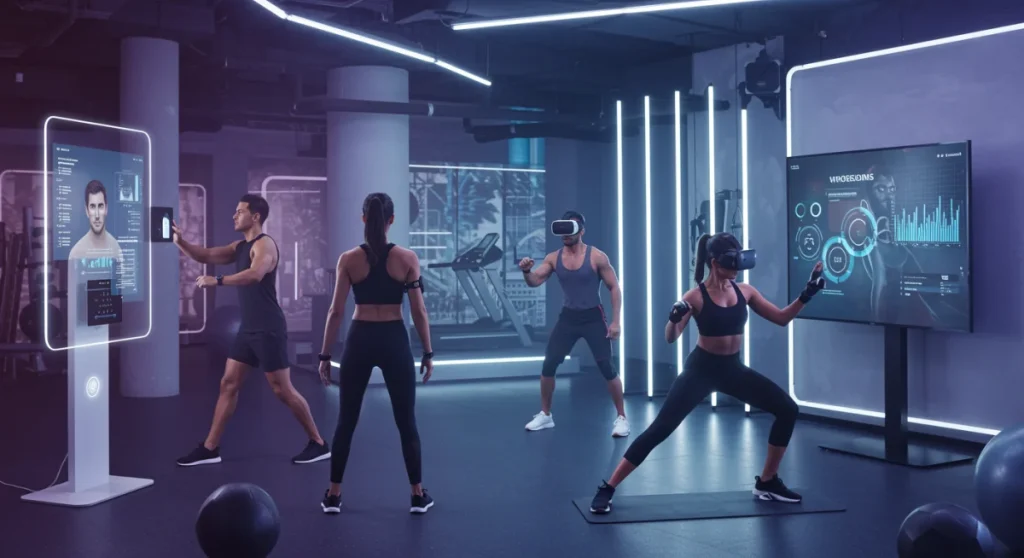Smart Fitness: 4 Tech-Driven Routines for 2025 in the US

The fitness landscape in the United States is rapidly evolving with technology, introducing innovative smart fitness routines that promise personalized, efficient, and engaging workouts for 2025 and beyond.
The world of fitness is constantly evolving, and as we look towards 2025, the integration of technology is no longer a luxury but a fundamental component of effective training. Smart fitness routines 2025 are rapidly gaining traction across the United States, transforming how individuals approach their health and wellness goals. These innovations offer unprecedented levels of personalization, engagement, and data-driven insights, making workouts more accessible and enjoyable for everyone.
The Rise of AI-Powered Personalized Training
Artificial intelligence (AI) is revolutionizing the fitness industry by offering hyper-personalized training experiences previously only available to elite athletes. AI algorithms analyze an individual’s data, including performance metrics, biometric information, and even dietary habits, to create dynamic workout plans that adapt in real-time.
This level of customization ensures that every exercise, repetition, and rest period is optimized for the user’s specific goals and physical capabilities. The result is a highly efficient and effective fitness journey that minimizes plateaus and maximizes progress.
How AI Transforms Your Workout
- Adaptive Programming: AI adjusts workout intensity and volume based on your daily performance and recovery.
- Form Correction: Some AI systems use computer vision to provide real-time feedback on exercise form, preventing injuries.
- Nutritional Guidance: AI can integrate with diet tracking to offer personalized meal plans that complement your training.
- Progress Prediction: Advanced AI models can predict future performance and suggest adjustments to keep you on track.
The beauty of AI-powered training lies in its ability to learn and evolve with you. It’s like having a personal coach who is always available, always informed, and always pushing you towards your best self. This routine is particularly appealing to those seeking optimal results and a deeply customized fitness experience.
Immersive Virtual Reality (VR) and Augmented Reality (AR) Workouts
Stepping into a virtual world for your workout is no longer a futuristic fantasy but a growing reality. VR and AR fitness routines are capturing the imagination of exercisers by transforming mundane workouts into exciting, gamified experiences. These technologies transport users to exotic locations, engage them in competitive challenges, or guide them through interactive classes, making exercise feel less like a chore and more like an adventure.
The immersive nature of VR/AR can significantly boost motivation and adherence to fitness programs. Users often find themselves pushing harder and longer because they are engrossed in the virtual environment, forgetting the physical exertion involved.
Popular VR/AR Fitness Applications
- Gamified Cardio: Games like Beat Saber and Supernatural turn rhythm-based movements into intense cardio sessions.
- Virtual Expeditions: Explore virtual landscapes while running on a treadmill or cycling, making indoor workouts more engaging.
- Interactive Coaching: AR overlays can provide virtual instructors or performance metrics directly in your field of view during exercises.
These experiences offer a fresh perspective on fitness, combining entertainment with physical activity. They are especially beneficial for individuals who struggle with traditional gym environments or need an extra layer of engagement to stay consistent with their routines. The blend of physical effort and digital immersion makes VR/AR workouts a compelling option for a diverse audience.
![]()
The Precision of Smart Wearables and Biometric Tracking
Smart wearables have evolved far beyond simple step counters. Today’s devices offer a sophisticated suite of biometric tracking capabilities, providing users with a comprehensive understanding of their body’s responses to exercise and daily life. From continuous heart rate monitoring and sleep analysis to stress detection and blood oxygen levels, these wearables are indispensable tools for optimizing health and performance.
The data collected by these devices enables users to make informed decisions about their training, recovery, and overall well-being. Understanding how your body reacts to different stimuli empowers you to fine-tune your routines for maximum benefit and prevent overtraining or injury.
Key Biometric Metrics Tracked
- Heart Rate Variability (HRV): An indicator of recovery and stress levels, guiding optimal training intensity.
- Sleep Stages: Detailed analysis of sleep cycles to improve sleep quality and recovery.
- Activity Levels: Comprehensive tracking of daily movement, calories burned, and active minutes.
- Body Composition: Some advanced wearables offer insights into muscle mass and fat percentage.
The integration of smart wearables into daily fitness routines provides an unparalleled level of insight into personal physiology. This data-driven approach allows individuals to train smarter, recover more effectively, and ultimately achieve their fitness goals with greater precision. It’s about listening to your body, amplified by cutting-edge technology.
Connected Home Gyms and Interactive Fitness Platforms
The pandemic accelerated the trend of home workouts, and connected home gyms have solidified their place as a cornerstone of modern fitness. Platforms like Peloton, Tonal, and Mirror offer interactive, instructor-led classes and personalized programs that bring the gym experience directly into your living room. These systems combine high-quality equipment with engaging digital content, fostering a strong sense of community and accountability.
Users can participate in live classes, compete with friends, and track their progress over time, all from the comfort and convenience of their homes. This accessibility removes common barriers to exercise, such as travel time or intimidation by traditional gym settings, making fitness more attainable for a broader audience.
Benefits of Connected Home Gyms
- Convenience: Work out anytime, anywhere, eliminating commutes and scheduling conflicts.
- Variety: Access a vast library of classes, from strength training and yoga to cycling and dance.
- Community: Engage with other users and instructors through leaderboards, live chats, and virtual events.
- Personalized Feedback: Many platforms offer performance metrics and personalized recommendations.
Connected home gyms represent a significant shift in fitness culture, empowering individuals to take control of their health without compromising on quality or engagement. They provide a comprehensive solution for those seeking a flexible yet structured approach to their fitness journey, ensuring consistency and continuous improvement.

Genomic-Based Fitness and Nutrition Plans
Moving beyond generic advice, genomic-based fitness and nutrition plans are emerging as a frontier in personalized wellness. By analyzing an individual’s DNA, these services provide insights into genetic predispositions that influence metabolism, muscle response, injury risk, and nutrient absorption. This scientific approach allows for the creation of truly bespoke fitness and dietary strategies.
Understanding your genetic blueprint can help tailor everything from the optimal type of exercise for muscle growth to the ideal macronutrient ratio for weight management. It moves away from trial-and-error, offering a precise, evidence-based roadmap to health.
What Genomic Data Reveals
- Exercise Response: Identify genetic markers related to endurance versus strength potential.
- Injury Susceptibility: Understand predispositions to certain types of injuries to implement preventative measures.
- Nutrient Metabolism: Discover how your body processes specific vitamins, minerals, and macronutrients.
- Weight Management: Gain insights into genetic factors influencing appetite, satiety, and fat storage.
While still a relatively niche area, genomic fitness holds immense potential for unlocking truly individualized health solutions. It promises to eliminate guesswork, allowing individuals to align their lifestyle choices with their unique biological makeup, leading to more sustainable and effective results. This advanced routine represents the pinnacle of personalized health.
The Future of Recovery: Smart Sleep and Stress Management
Fitness is not just about the workout; it’s equally about recovery. In 2025, smart technologies are increasingly focusing on optimizing sleep and managing stress, recognizing their critical role in overall performance and well-being. Devices and applications now offer sophisticated tools to monitor sleep patterns, provide guided meditation, and track stress indicators, helping users achieve optimal physical and mental restoration.
Poor sleep and chronic stress can undermine even the most diligent fitness efforts. By leveraging technology to understand and improve these aspects of health, individuals can enhance their recovery, boost energy levels, and reduce the risk of burnout or injury. This holistic approach ensures that the body is always primed for peak performance.
Technological Aids for Recovery
- Smart Mattresses and Sleep Trackers: Monitor sleep cycles, temperature, and breathing to optimize sleep environments.
- Wearable Stress Sensors: Detect physiological signs of stress and offer real-time relaxation techniques.
- Meditation Apps with Biometric Feedback: Guide users through mindfulness exercises while tracking their physiological responses.
The emphasis on smart recovery solutions underscores a growing understanding that health is a comprehensive endeavor. By integrating advanced tools for sleep and stress management, fitness routines become more sustainable and effective, contributing to long-term well-being and consistent performance. This approach ensures that every aspect of health is optimized.
| Key Trend | Brief Description |
|---|---|
| AI Training | Personalized workouts adapting in real-time based on individual data and goals. |
| VR/AR Workouts | Immersive, gamified experiences making exercise engaging and adventurous. |
| Smart Wearables | Advanced biometric tracking for precise health and performance optimization. |
| Connected Home Gyms | Interactive platforms bringing gym-quality workouts and community into the home. |
Frequently asked questions about smart fitness routines
AI-powered routines offer highly personalized workout plans that adapt in real-time, optimizing each session for individual goals and capabilities. This leads to more efficient progress, reduced risk of injury through form correction, and sustained motivation, making fitness more effective and tailored.
VR/AR workouts transform traditional exercise into engaging, gamified experiences by immersing users in virtual environments. This immersion significantly boosts motivation, reduces perceived exertion, and makes workouts more enjoyable, often leading to increased consistency and adherence to fitness programs.
Smart wearables track a wide array of biometric data, including continuous heart rate, heart rate variability (HRV), sleep stages, activity levels, and stress indicators. This comprehensive data provides deep insights into the body’s responses, aiding in workout optimization and recovery planning.
Yes, connected home gyms offer a highly viable alternative, providing interactive, instructor-led classes and personalized programs from home. They offer convenience, a vast variety of workout options, and a sense of community, making fitness accessible and engaging for many individuals.
Genomic-based fitness uses an individual’s DNA to identify genetic predispositions affecting metabolism, muscle response, and injury risk. This allows for truly bespoke exercise and nutrition plans tailored to one’s unique biological makeup, moving beyond generic advice for highly precise results.
Conclusion
As we navigate towards 2025, the landscape of fitness in the United States is undeniably shaped by technological advancements. The integration of AI, VR/AR, smart wearables, and connected home gyms is not merely a trend but a fundamental shift towards more personalized, engaging, and effective approaches to health and wellness. These innovations empower individuals to take a proactive and informed role in their fitness journeys, breaking down traditional barriers and making healthy living more accessible than ever before. Embracing these smart fitness routines means stepping into a future where your workout is as unique as you are, driven by data, and designed for optimal results.





